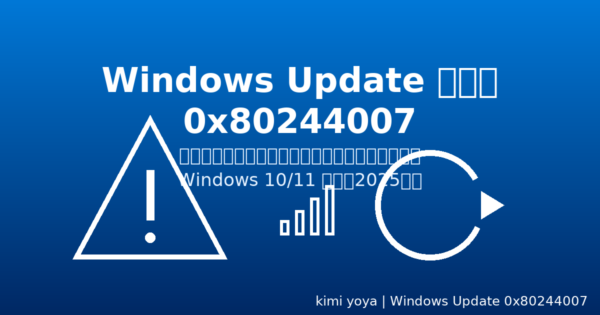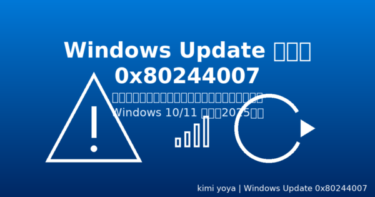
Comprehensive Troubleshooting for Connectivity, Cache Corruption, and Proxy Issues
- 1 Introduction
- 2 What Does Error 0x80244007 Mean?
- 3 Main Causes
- 4 Quick Preliminary Checks (Takes ~5 Minutes)
- 5 Core Fix Steps
- 6 Advanced Fixes (System-Level Repairs)
- 7 FAQ
- 8 Preventing Recurrence
- 9 Summary Table: Error 0x80244007 Overview
- 10 Conclusion
Introduction
Windows Update error 0x80244007 can occur when your device fails to communicate properly with Microsoft’s update servers.
This issue often appears during update checks or downloads, particularly after new cumulative or preview updates (like KB5067036 or KB5067931).
It’s usually caused by temporary network instability, corrupted update cache, or leftover proxy/DNS configurations from VPN or enterprise setups.
In this guide, you’ll learn how to diagnose and resolve the problem — from basic quick fixes to deeper DISM and SFC repair methods — all in a clear, step-by-step approach.
What Does Error 0x80244007 Mean?
The error 0x80244007 indicates a failure in the communication session between your Windows Update client and Microsoft’s update servers.
It doesn’t necessarily mean your system is damaged — rather, something disrupted the data exchange or authentication process.
Common scenarios include:
- Update checks getting stuck at “Downloading…” or “Checking for updates”
- The process resets or throws “0x80244007” after several minutes
- Other internet services (browser, apps) work normally, but Windows Update does not
Main Causes
| Category | Description |
|---|---|
| Network instability / VPN interference | VPN or firewall temporarily blocks Microsoft Update domains. |
| Corrupted Update Cache | Files in C:\Windows\SoftwareDistribution become partially written or unreadable. |
| Proxy / DNS residue | Leftover settings from corporate networks, WPAD auto-detection, or custom DNS. |
| Update services glitch | Windows Update (wuauserv) or Background Intelligent Transfer Service (BITS) not responding. |
Quick Preliminary Checks (Takes ~5 Minutes)
Before diving deeper, try the following:
- Disable VPN or Security Software Temporarily
If you use a VPN or corporate firewall, disconnect it for a few minutes and retry Windows Update. - Switch Your Network
Toggle between Wi-Fi and Ethernet or try another access point. - Verify Date and Time Settings
Go to Settings → Time & language → Date & time → enable “Set time automatically.” - Restart Your PC
A full shutdown → power-on helps reload the Windows Update stack after major patches.
Core Fix Steps
Step 1: Restart Windows Update Services and Rebuild the Cache
Open Command Prompt (Admin) or Windows Terminal (Admin) and run:
net stop wuauserv
net stop bits
del /s /q %windir%\SoftwareDistribution\*
net start wuauserv
net start bits
This clears the update cache without deleting the folder itself.
After restarting the services, try checking for updates again.
Step 2: Reset the WinHTTP Proxy
netsh winhttp show proxy
netsh winhttp reset proxy
If your system reports anything other than “Direct access (no proxy)”,
it means a proxy or auto-configuration (WPAD) setting may be interfering.
Step 3: Flush DNS Cache
ipconfig /flushdns
This clears stale DNS entries that may route update requests incorrectly.
Step 4: Refresh Windows Store Update Components (Optional)
wsreset.exe
This resets the Microsoft Store cache, which sometimes shares update mechanisms with Windows Update.
Step 5: Try Checking for Updates Again
Go to:
Settings → Windows Update → Check for updates
If KB updates still fail, continue with system-level integrity repair below.
Advanced Fixes (System-Level Repairs)
1) Run DISM and SFC to Repair System Image Integrity
What DISM Does
DISM (Deployment Image Servicing and Management) repairs the Windows component store (WinSxS).
If that store is corrupted, Windows Update cannot validate or apply updates correctly.
Run These Commands
Open Command Prompt (Admin):
DISM /Online /Cleanup-Image /RestoreHealth
This scans and automatically downloads missing components from Windows Update.
Expect the process to take 10–30 minutes.
If it seems “stuck” at certain percentages (e.g., 20%, 62.3%), don’t close the window — it’s still processing.
Optional Pre-checks
DISM /Online /Cleanup-Image /CheckHealth
DISM /Online /Cleanup-Image /ScanHealth
These check for corruption but do not fix anything.
If issues are found, proceed with /RestoreHealth.
Offline or Local Source Repair (for WSUS or Proxy Environments)
If you get error 0x800f081f or 0x800f0906, DISM cannot fetch files online.
Use a local Windows 11 ISO instead:
- Mount your ISO (e.g., it appears as drive D:)
- List available editions:
DISM /Get-WimInfo /WimFile:D:\sources\install.wim - Run DISM using the correct index (e.g., 6 for Windows 11 Pro):
DISM /Online /Cleanup-Image /RestoreHealth /Source:wim:D:\sources\install.wim:6 /LimitAccess
Then Run SFC
sfc /scannow
SFC repairs actual system files using the restored component store.
Log Files
- DISM log:
C:\Windows\Logs\DISM\dism.log - SFC log:
C:\Windows\Logs\CBS\CBS.log
2) Review Proxy & Network Settings
Go to: Settings → Network & Internet → Proxy
- Toggle “Automatically detect settings” off → on
- Ensure “Use a proxy server” is turned off
- If WPAD or custom DNS is configured, reset them via:
netsh winhttp reset proxy ipconfig /flushdns
3) Apply Updates from a New Local Admin Account
If your user profile has damaged permissions or cached policies, create a new local administrator and try Windows Update again.
4) Group Policy and WSUS Conflicts (Enterprise Users)
If your PC was once joined to a corporate domain:
- Open Group Policy Editor (
gpedit.msc) - Navigate to:
Computer Configuration → Administrative Templates → Windows Components → Windows Update - Set “Specify intranet Microsoft update service location” to Not Configured
Or via registry:
HKLM\Software\Policies\Microsoft\Windows\WindowsUpdate\AU
UseWUServer = 0
Restart the computer afterward.
FAQ
Q1: Can I ignore this error?
Not recommended. Without updates, your PC may miss important security or compatibility patches.
Q2: The error keeps coming back even after fixes.
A recurring cause is a VPN or third-party firewall re-enabling its proxy automatically.
Add Windows Update to its allowlist/exclusion settings.
Q3: Which fix works best?
In most cases, resetting the update cache + WinHTTP reset resolves it.
If not, DISM + SFC nearly always fixes the underlying corruption.
[PR] Recommended Tools for Stable Updates
Preventing Recurrence
- Disable VPN during major updates
- Regularly clear the proxy cache (
netsh winhttp reset proxy) - Reboot router/modem once a month
- Before Patch Tuesday, create a restore point or image backup
- Avoid shutting down mid-update
Summary Table: Error 0x80244007 Overview
| Item | Details |
|---|---|
| Error Code | 0x80244007 |
| Main Causes | Network instability, cache corruption, proxy/DNS residue |
| Initial Steps | Disable VPN/firewall, verify time/date, reboot |
| Core Fix | Restart wuauserv/BITS, clear cache, reset proxy/DNS |
| Advanced Repair | DISM /RestoreHealth + SFC /scannow |
| Preventive Measures | Allowlist Windows Update, remove old WSUS policies, regular backups |
Conclusion
Windows Update error 0x80244007 typically results from a combination of network miscommunication and system cache issues, not from major corruption.
By proceeding in order — quick checks, cache rebuild, proxy reset, then DISM/SFC — most users can restore normal update function without reinstalling Windows.
Once fixed, setting up a regular backup and update routine helps ensure the error doesn’t return during future cumulative or preview updates.
Related Articles
・Fix KB5070883 Installation Failure on WSUS (Windows Server 2019)
・How to Fix Windows Update Error 0x800705b9 on Windows 10/11
・Fix Windows 11 Update KB5070773 Failing with Error 0x800f0983 (24H2 / 25H2)


